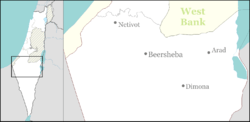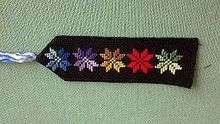Lakiya
Lakiya, or Laqye (Hebrew: לָקִיָּה) is a Bedouin town (local council) in the Southern District of Israel. In 2019 it had a population of 14,075.[2]
Lakiya
| |
|---|---|
| Hebrew transcription(s) | |
| • Also spelled | Laqye (official) |
 Lakiya | |
| Coordinates: 31°19′11″N 34°51′33″E | |
| District | Southern |
| Founded | 1982 |
| Government | |
| • Type | Local council |
| • Head of Municipality | Khaled el-Sana[1] |
| Area | |
| • Total | 5,728 dunams (5.728 km2 or 2.212 sq mi) |
| Population (2019)[2] | |
| • Total | 14,075 |
| • Density | 2,500/km2 (6,400/sq mi) |
History
Lakiya was founded in 1985 as part of a government project to settle Bedouins in permanent settlements.[3] It is one of the seven original government-planned Bedouin townships in the Negev desert.[3][4]
In December 2009, the town was ranked lowest (1 out of 10) in socio-economic standing, with an average income of 4,360 shekels compared to the national average of 7,070. Only 58.2% of grade twelve students are eligible to graduate from high school.
In 1999 the first local council elections were held, with Sheikh Ibrahim Abu Maharab elected as council head. Abu Maharab was later succeeded by Khaled al-Sana.
Demographics
According to the Israel Central Bureau of Statistics (CBS), the population of Lakiya was 9,943 in December 2010[5] (7,600 in December 2004). Its annual growth rate is 3.1%. Lakiya's jurisdiction is 5,728 dunams (5.7 km²).
There are several Bedouin clans residing in Lakiya, al-Sana being the largest among them. Other families are: Al-Assad, Abu Ammar and Abu Maharab. Some clans don't live inside Lakiya, but on adjacent territory.
Economy
In 2013, Arab-Bedouin women from Lakiya and other Bedouin towns participated in a sewing course for fashion design at the Amal College in Beer Sheva, including lessons on sewing and cutting, personal empowerment and business initiatives.[6]
Weaving and embroidery projects
The Lakiya Negev Weaving Project was founded in 1991, its aim is to empower Negev Bedouin women by applying their traditional weaving skills to the manufacture and sale of woven products.[7] It is based completely on the unique Bedouin heritage passed on from mother to daughter. Approximately 130 Bedouin women are involved in this project in all the stages of the production from initial wool treatment, weaving the rugs, cushion covers and pouches, and selling.[8] These women were provided guidance, professional consulting and hands-on assistance in the fields of marketing, branding, sales, the business's organizational structure and business plan, fundraising and networking. The project's aim was to make it a successful, profitable and financially independent cooperative business.[9] It is about to succeed - several retailers and chains sell Bedouin traditional ground-looms all over Israel, including Haifa, and also abroad.[10] A new visitors' center will be open soon but it has already become a tourist site.

Another tourist site is the Desert Embroidery Project.[11] Some 20 women completed their professional entrepreneurial and business training and guidance and initiated a project based on the design and production of the traditional Bedouin costume jewelry. They are producing this embroidery at home with traditional Bedouin motifs and decorations. The women also hold Bedouin embroidery workshops and events based on the Bedouin tradition. Their workshop is also a visitors' center and it is a famous tourist attraction in the area.[12]
Healthcare
There are branches of several health funds (medical clinics) in Lakiya: Leumit, Clalit and several Tipat Halav well baby clinics .
Education and culture
There are a number of schools in the township and a communal activity center.
Notable residents
- Taleb el-Sana, an Israeli politician, the longest serving Arab member of the Knesset
- Ismael Abu-Saad, professor of education, Ben-Gurion University of the Negev[13]
- Amal Elsana Alh'jooj, spokesperson for the Bedouin women, co-executive director of the Negev Institute for Strategies of Peace and Development (NISPED), a founding director of the Arab-Jewish Center for Equality, Empowerment and Cooperation (AJEEC); a member of Prime Minister's Commission for Economic Development of the Arab Sector.[14] She established the first Arab Bedouin women's organization to improve the situation of Bedouin women at the age of 17.[15]
- Roz Willey as-Sana, Bedouin Weaving project coordinator[16][17]
See also
References
- PM Netanyahu meets with Negev Bedouin mayors Archived 2017-02-03 at the Wayback Machine MFA, November 3, 2011
- "Population in the Localities 2019" (XLS). Israel Central Bureau of Statistics. Retrieved 16 August 2020.
- Human Rights Watch (Organization) (2008). Off the Map: Land and Housing Rights Violations in Israel's Unrecognized Bedouin Villages. Human Rights Watch. p. 16. GGKEY:X3Z6UW6BJ3C.
- State of Israel. Ministry of Justice, Ministry of Foreign Affairs. List of Issues to be taken up in Connection with the Consideration of Israel's Fourth and Fifth Periodic Reports of Israel (CEDAW/C/ISR/4 and CEDAW/C/ISR/5) Archived 2013-10-15 at the Wayback Machine
- "Statistical abstract of Israel 2011. POPULATION AND DENSITY PER SQ. KM. IN LOCALITIES NUMBERING 5,000 RESIDENTS AND MORE ON 31 XII 2010(1)" (PDF). Israel Central Bureau of Statistics. Archived from the original (PDF) on 2012-01-05. Retrieved 2010-12-31.
- "Economic Empowerment. Arab-Bedouin Fashion Design". Nisped.org.il. Archived from the original on 2013-10-15. Retrieved 2013-11-19.
- Lakiya Negev Weaving
- Classic rug collection introduces Lakiya Rugs at Jewish marketplace
- "Bedouin projects. Lakiya Negev Weaving". Cjaed.org.il. Archived from the original on 2013-10-14. Retrieved 2013-11-19.
- "Israeli Bedouin Weavers from Lakiya at Santa Fe International Folk Art Market". Iataskforce.org. Retrieved 2013-11-19.
- "Bedouin Tourist Sites". Itn.co.il. Retrieved 2013-11-19.
- "Economic empowerment. Training Course in Jewelry Design and Production". Nisped.org.il. Archived from the original on 2013-10-15. Retrieved 2013-11-19.
- Talya Halkin. Empowering the disempowered Jerusalem Post, November 5, 2005
- "Ms. Amal Elsana Alh'jooj, Israel". Presidentconf.org.il. Retrieved 2013-11-19.
- Eddie Shiyovits- edis, http://www.nisped.org.il. "Amal Elsana Alh'jooj – Short Bio". Nisped.org.il. Retrieved 2013-11-19.
- "About us". Bedouinweaving.com. Retrieved 2013-11-19.
- Desert Weavings Archived February 25, 2009, at the Wayback Machine
External links
- Lakiya Negev Weaving - website of one of Lakiya's main businesses
- Lands of the Negev, a short film presented by Israel Land Administration describing the challenges faced in providing land management and infrastructure to the Bedouins in Israel's southern Negev region